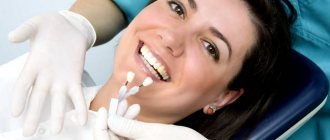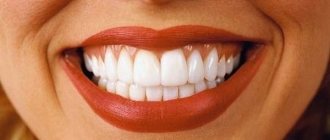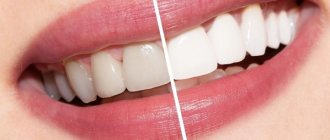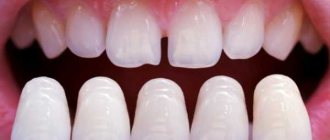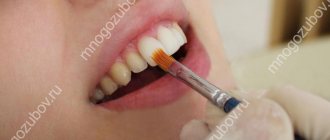Tetracycline teeth are characterized by the appearance of unnatural shades in the tooth enamel and are caused by the penetration of large or small doses of the antibiotic tetracycline into the body. The route of penetration does not matter - oral administration of drugs and applications to mucous membranes, for example, are also to blame.
Tetracycline intervention occurs in several ways. Often the child receives the drug from the mother while still inside the womb. A pregnant woman, possibly as a result of self-medication or prescribed serious therapy, takes tetracycline. The baby is born with a pathology that becomes visible at the time of teething.
It happens that pediatricians prescribe tetracycline treatment to children under 14 years of age. At this age, the enamel has not yet completed its formation cycle, therefore it is vulnerable and capable of absorbing the medicinal component.
Antibiotics are used to treat diseases that do not require easy progression and self-treatment: pneumonia, ulcers, cholera. Tetracycline also has a good effect on painful skin formations, various rashes, bacteriological lesions, etc. The doctor is obliged to warn the patient about the consequences of such therapy. Not only the enamel is at risk, the marginal periodontium as a whole is also weakened.
Sometimes a change in the color of the enamel occurs in an adult who has not been treated with an antibiotic. But teeth are still called tetracycline teeth - for a similar external effect. The list of possible reasons includes:
- Products containing chemicals and dyes;
- Atypical manifestations of allergies;
- The influence of hard ultraviolet radiation;
- A special reaction of the body to an internal or external stimulus.
An antibiotic that has entered the body cannot be removed. Its danger lies in the possibility of delayed action. That is, a person is being treated now, but the reaction will occur years later.
What colors are tetracycline teeth?
Most often, the enamel in the cervical area of the tooth is affected - it is this area that is the first to form in the fetus. Dynamics of similar frequency are observed when tetracycline is deposited in the lateral parts, in the folds of the enamel. Sometimes all the teeth in a row show the same even shade, and sometimes the color is distributed in spots, making the teeth look mosaic.
The color palette is almost always shifted to the left side of the spectrum. Teeth acquire yellow, brown, orange and brown shades in various variations. Sometimes the enamel looks gray.
How to treat?
Patients with this problem experience discomfort and cannot boast of an open smile. In addition, there is a high probability of developing other diseases, so treatment should not be delayed.
The dentist chooses treatment methods depending on the progress of the disease:
- First degree violation. Bleaching using fluoride-containing solutions is possible.
- Second degree. A stronger effect is needed - ultrasonic bleaching is used. Additionally, enamel remineralization is used to restore it. In difficult cases, intracanal cleaning with chemical compounds is necessary.
- Third degree. The damage is so severe that restoration of the dental elements is necessary. Glass ionomer cement is used to restore the affected areas, lamination.
In addition, calcium supplements and vitamin complexes are prescribed to restore tooth enamel.
In difficult cases, when the shade appears again after any type of whitening, dentists resort to microprosthetics. Veneers or ceramic crowns are installed.
Diagnosis of tetracycline teeth
Treatment of teeth affected by tetracycline requires correct diagnosis. Human teeth can change color when exposed to a variety of dyes. This situation is familiar to smokers with teeth yellowed by nicotine, lovers of strong coffee, red wine, etc. Teeth can change color due to developing caries, darken as a result of nerve removal, or taking iron supplements.
Tetracycline teeth are easy to identify. Under UV radiation they begin to glow brightly, and the doctor determines the cause of the lesion.
Causes of the defect
This type of pigmentation occurs only in one case - the accumulation of tetracycline salts in the body. It is used quite rarely for the treatment of severe bacterial ailments:
- pneumonia;
- cholera;
- acne;
- ulcers.
The accumulation of the substance occurs in bone tissue, and it is impossible to remove it from the body. Moreover, a change in enamel may not occur immediately, but may be provoked by other reasons. Important! Medicines containing tetracycline are contraindicated in children under 14 years of age, pregnant women and women during lactation.
Remineralization of tooth enamel
The lack of mineral components during the formation of enamel is the main source of the formation of tetracycline teeth. When restoring enamel, applications with calcium gloconate and sodium fluoride are effective. The phonophoresis procedure is used. The goal of therapy is to supply ions of the main elements to the enamel: calcium, phosphorus and fluorine.
Treatment is carried out in the clinic, and in case of slight darkening, outpatient treatment at home is allowed. Up to 20 procedures will be required. If performed daily, therapy will end after three weeks or earlier. With a course of use every other day, it will take up to one and a half months.
In this case, the patient did not have any serious problems with aesthetics. I wanted to significantly lighten my teeth and improve their shape. If we were talking about traditional veneers, we would dissuade the patient from the procedure.
There is no point in sacrificing dental health for aesthetics. In this case, the patient did not have any serious problems with aesthetics. I wanted to significantly lighten my teeth and improve their shape. If we were talking about traditional veneers, we would dissuade the patient from the procedure. There is no point in sacrificing dental health for aesthetics.
With Luxneers you don’t have to choose between health and beauty - you can create a perfect smile without sacrifice! The teeth are not subjected to grinding and you can return to your “natural smile” at any time. The procedure is comfortable, installation is absolutely painless!
Find out more about Luxneers no-preparation veneers
Symptoms of tetracycline pigmentation
The depth of enamel damage depends on the amount of accumulated tetracycline in the body. If its concentration is low, only the natural color of the enamel will be changed. At significant doses, a pathological change in the color of the surface of all teeth is observed. Tetracycline does not cause caries, therefore, with noticeable external defects, the teeth do not have painful symptoms. Often, not the entire tooth is stained, but only certain parts of it. Depending on how long tetracycline was in the body, enamel pigmentation will have the following degrees of damage:
- Subtle and uniform color change.
The teeth are colored brown, gray or yellow without stains or structural changes in the surface. At this stage, the problem is solved by in-office whitening, provided there are no contraindications.
- Complete and profound change in tooth color.
This degree of change occurs with long-term use of the antibiotic. The return of whiteness is possible with deep, sometimes even internal bleaching.
- Deep discoloration at the junction of teeth and gums.
Such symptoms accompany underdeveloped enamel, and the problem can only be solved by applying veneers.
Tetracycline Teeth Whitening
After the initial stage of treatment, most patients with tetracycline teeth will require aesthetic therapy.
It is acceptable to try to whiten dark teeth if your doctor supports this method of restoring the beauty of your smile. The technique will show results if the initial darkening is slight and uniform. However, a situation often occurs when, after a short period of time, the teeth return to their previous color, neutralizing the results of whitening. The patient has to repeatedly subject himself to the procedure in an attempt to achieve harmony.
Any whitening methods acceptable for a particular patient are allowed - hardware and home use. If the result is persistently unsatisfactory, there is only one way out - to resort to dental restoration.
Prevention
The risks of tetracycline teeth are now a well-known problem, so doctors familiar with it try to avoid, if possible, recommending tetracycline antibiotics for pregnant women and children under 12 years of age. But if there are no other possibilities, then, unfortunately, you have to choose the priority of the general health of the mother and child. The doctor may try to make the course of antibiotic therapy as short as possible, since the inclusion of antibiotic molecules in growing dental tissues is a process that takes quite a long time.
Request a consultation
Restoration of tetracycline teeth with veneers
Veneers are a good way out if your own teeth, given by nature, are no longer pleasing. The term refers to extremely thin plates that are placed on the tooth and cover its front part like a shield.
There are a number of technologies for installing veneers. Designs are divided into direct and indirect. The cost of the former is quite affordable for any patient. They are made quickly; the technique is based on layering a composite material on the vestibular part of the tooth.
Hollywood veneers, like those of movie stars, are glued with a special glue; sometimes preliminary grinding of the enamel is required. By analogy with the previous ones, they are very similar to natural enamel, and the doctor enhances the identity by selecting a similar shade and transparency of the veneer according to the Vita scale. Mostly installed on incisors.
The third type of veneers combines expensive lumineers and ultraneers. These plates are attached to the teeth without preparing the enamel. They can be used to cover all teeth in a row, including chewing ones. An additional advantage of lumineers is their extraordinary whiteness and long service life.
Causal factor of the disease
The cause of tetracycline teeth is the use of tetracycline drugs, both in young children and in women carrying a baby. Taking tetracycline by pregnant women does not affect the health of the expectant mother, but it does affect the development of the child’s teeth. The color of the enamel does not change immediately, but gradually. It depends on some factors:
- From the individual characteristics of the body.
- From a balanced or unbalanced diet.
- From the body's response to the action of the drug.
- From ultraviolet exposure.
Restorative bleaching methods
There are two options for restorative teeth whitening. One of them is direct, during which the dentist performs the procedure directly on the enamel without first creating plates. In this case, the material is applied in a very thin layer. Another method is indirect, in which the thinnest (up to 0.3 mm) lumineers plates are installed. They are selected from existing templates or made from individual casts. In the second case, the price for restorative teeth whitening will be higher.
Indications for restorative bleaching:
· the appearance of dark marks on the teeth, stains from silver fillings;
· “tetracycline teeth”;
· fluorosis;
· high sensitivity of enamel;
· minor cracks;
· minor damage to the crown.
It should be noted that the restorative bleaching procedure is intended primarily to get rid of aesthetic defects. If the patient has more serious defects and dental diseases, it is necessary to turn to other restoration methods, discussing the available options with the dentist.
Can it be avoided?
In order to protect yourself from defects, you should be careful about the medications you take. Use tetracycline only as prescribed by a doctor; usually, therapists and other specialists prescribe antibiotics only when absolutely necessary.
In the event that an infant or an older child falls ill, and the pediatrician prescribes a tetracycline-containing drug, the dosage should be observed as accurately as possible, it should be reduced by him, and do not continue the course more than indicated.
Teeth exposed to this antibiotic cause discomfort to their owner. In order to avoid such problems, you should approach any course of therapy wisely and not self-medicate.
How is restorative bleaching performed?
The procedure takes place in several stages:
· select the desired shade of enamel;
· teeth are treated with a specialized brush and toothpaste;
· a bonding agent is applied, which has healing properties, makes the enamel less sensitive, and prevents the entry of bacteria.
Composite material is applied to the front part of the tooth;
· To create a radiant effect, the surface of the tooth is polished.
· Post-procedure care
To strengthen the result, after lightening you must follow some rules, this will help extend the service life of the plates:
· Take good care of your oral cavity;
· give up cigarettes;
· do not drink coloring drinks (red wine, soda, coffee, etc.);
· do not bite seeds, do not eat toffees and other sticky foods.
In addition, you need to regularly visit the dentist to monitor the condition of the plates.
What is recommended after whitening?
After the procedure, it is important to maintain a white diet if possible to prolong the results. During the first 3 days, eating food with bright aggressive dyes, as well as drinking tea or coffee without milk, is strictly prohibited. For 2 weeks you need to smoke as little as possible (smoker's plaque can form very quickly and penetrate deeply into the thickness of the enamel, so it will not be easy to remove).
Further, to maintain the result, it is necessary to monitor the level of hygiene and carry out professional cleaning once every six months at the dentist. Then your smile will be healthy and snow-white longer.
At Dr. Lemberg's Dental Clinic, specialists know everything about how to make your smile snow-white and healthy! Book a consultation and find out which professional whitening method is right for you!
Photobleaching
This is the most common method of teeth whitening. Its huge advantage is the durability of the effect. With the proper level of care, the whiteness will last up to 2 years!
This technique also uses whitening gels with the same composition, but in addition to them, a catalyst in the form of cold light is also used. For this purpose, special lamps were created, with the help of which the manipulation is performed quickly and very effectively. The most advanced photo whitening system is Beyond Polus, and it is the best way to professionally whiten your teeth. Essentially, the same chemical reaction occurs between the tooth and the gel, but thanks to the light, active oxygen penetrates much deeper into the enamel and removes more pigment. Therefore, the result of this procedure is lightening by 10-12 tones.
American corporation Beyond International Inc. declares that it has created a fundamentally new approach in this regard. Activation of the gel components in this case takes place under the influence of an LED lamp and halogen light. But unlike well-known photo-whitening techniques, such as ZOOM, overheating of the enamel-dentin layer of the tooth does not occur here. The lamp produces not warm, but cold light of the blue spectrum; when it hits the teeth, it additionally passes through 12 levels of protection and through special lenses that block harmful infrared radiation and protect you from ultraviolet radiation.
Description of the technique
To begin with, the doctor determines the existing color of the patient’s tooth enamel and reports on the possible results after the procedure. The patient's cheeks and lips are then isolated from the teeth. In this case, the gums need protection from burns when applying the active gel, so they are also isolated from the outer surface of the teeth. When the oral cavity is prepared, apply gel with peroxide, distribute it evenly over all teeth in the smile area and turn on the lamp. A new portion of the gel is applied every 20 minutes, one cycle takes 60-90 minutes.
The cost of this procedure is 25,000 rubles, and the result can last up to 2 years!
Zoom4 whitening is also widely used in dentistry; the only disadvantage of this procedure is the increased sensitivity of the teeth both during and after the procedure. This is due to the fact that Zoom lamps produce warm spectrum light, which leads to heating of the enamel.
Professional hygiene
Professional teeth cleaning in itself is not a whitening method, however, one of the bonuses of this service is the whitening of teeth by removing pigmented plaque. The first step is to remove hard dental deposits (tartar) using ultrasound, and then use AirFlow to cleanse the teeth of superficial pigmented plaque. Regular brushing allows you to maintain not only healthy teeth, but also the whitening effect for several years!
Contraindications
There are general and local ones. If the former are present, any bleaching is contraindicated. In case of local contraindications, clinical bleaching is not recommended.
Common ones include:
- Age up to 18 years
- Pregnancy, lactation period
- Receiving chemotherapy
- Taking tetracyclines or tretinoin and other light-sensitive drugs
Local contraindications include:
- Caries
- Wedge-shaped defects
- Presence of orthopedic structures in the smile area
- Presence of fillings
- Periodontitis
- Increased gag reflex
Treatment
If the tooth is uniformly and slightly grayish or yellowish in color, then it can be easily bleached, and usually this procedure is sufficient. Laser whitening and whitening using the Zoom system have a good effect.
If the tooth is uniformly colored in an intense yellow or gray color, you can try to whiten it, but it is usually best to restore it with veneers.
If the tooth is colored unevenly in an intense color, and the color looks like horizontal stripes, then in this case bleaching is completely ineffective, and the only treatment option is either restoration with veneers or covering the tooth with a crown.
In case of tetracycline damage to teeth, it is imperative to carry out a procedure for remineralization of the enamel, since the disease causes a violation of its mineralization.

